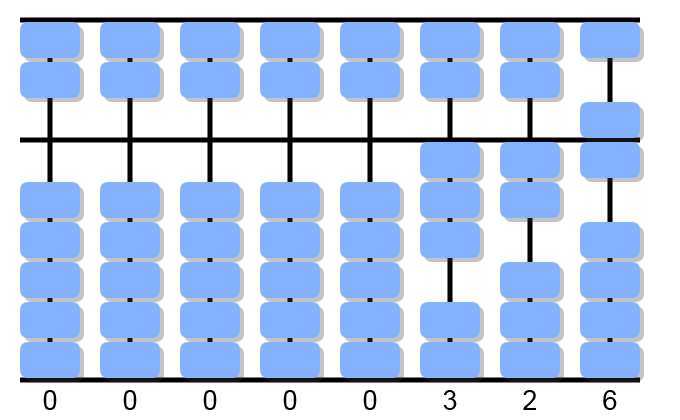
To add two numbers, the first number should be represented on the abacus and then add the second number. When this is not immediate, there are some rules about how to move the beads.
These rules use fourbasic concepts:
Rise: consists in moving up a hypobead. For each one, 1 unit is added.
Lower: consists in moving down an altobead. For each one, 5 units are added.
Cancel: consists in removing the beads from the middle bar. The removed beads will not be taken into account.
Forward: consists in moving up a hypobead from the adjacent column on the left. For each one 10, units are added.
Ideally, addition is achived simply moving beads to the middle bar, but sometimes there are not enoght beads to move.
In such cases there are 17 guides for addition:
| +1 | lower 5 cancel 4 |
forward 10 cancel 9 |
|
|---|---|---|---|
| +2 | lower 5 cancel 3 |
forward 10 cancel 8 |
|
| +3 | lower 5 cancel 2 |
forward 10 cancel 7 |
|
| +4 | lower 5 cancel 1 |
forward 10 cancel 6 |
|
| +5 | forward 10 cancel 5 |
||
| +6 | forward 10 cancel 4 |
forward 10 cancel 5 rise 1 |
|
| +7 | forward 10 cancel 3 |
forward 10 cancel 5 rise 2 |
|
| +8 | forward 10 cancel 2 |
forward 10 cancel 5 rise 3 |
|
| +9 | forward 10 cancel 1 |
forward 10 cancel 5 rise 4 |
We place 7 units.

+5: forward 10, cancel 5.


Result: 12.
We place 8 units, 5 tens and 2 hundreds.

We start the sum from the units:
+8: forward 10, cancel 2.

+6: forward 10, cancel 5, rise 1.

+9: forward 10, cancel 1.

Result: 1226.
Click on this link to practice the addition with one figure.
Click on this link to practice the addition with more figures.